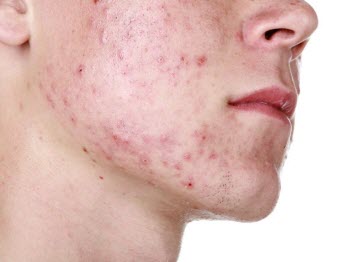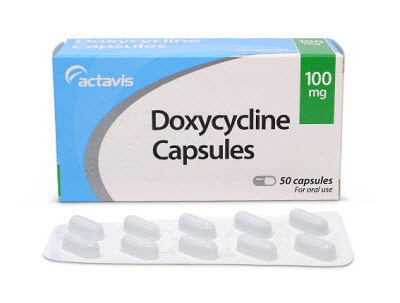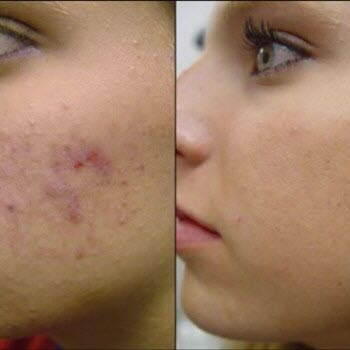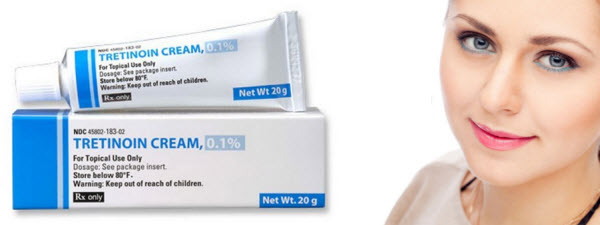Anti acne tablets Doxycycline and topical cream Tretinoin for acne
Contents
- Best way to get rid of acne. Acne remedies
- Topical acne treatment. The best prescribed medicine
- The best oral acne products. Antibiotics for acne
- Doxycycline acne treatment. Doxycycline 100mg for acne
- How does Doxycycline work?
- Contraindications for use of Doxycycline
- Efficiency of receiving Doxycycline for acne. Before and After pics
- Best acne cream Tretinoin. Topical cream for acne
 If a person sees that none of the folk remedies help him get rid of pimples and acne, then it's time to visit a specialist. In more complex cases, when large areas of the skin affect the rash, inflammation and other shortcomings - simple drugs can not do anything. The dermatologist, taking into account the level of complexity of the "illness", as well as the individual characteristics of the organism, prescribes a course of antibiotics.
If a person sees that none of the folk remedies help him get rid of pimples and acne, then it's time to visit a specialist. In more complex cases, when large areas of the skin affect the rash, inflammation and other shortcomings - simple drugs can not do anything. The dermatologist, taking into account the level of complexity of the "illness", as well as the individual characteristics of the organism, prescribes a course of antibiotics.
Wrong dose can not only help solve the problem of the ill-fated, but also aggravate the situation up to the systemic violations of the body's functioning.
Acne is an inflammation of the sebaceous glands and hair follicles, manifested by the appearance on the skin (mainly on the face and back) of a multitude of rashes. One of the main contributing factors in the development of pathology is the active development of bacteria in the ducts of the sebaceous glands. That is why antibiotic therapy is an integral part of the treatment of acne. Antibiotics for acne act on one of the main causes of inflammation, allowing you to get rid of the unpleasant, aesthetic discomfort of skin pathology.
Best way to get rid of acne. Acne remedies
Types of antibiotics to fight acne
Antibiotics are pharmacological agents of natural or synthetic origin, which inhibit the vital activity processes of pathogenic bacteria.
According to the mechanism of action of antibiotics for the treatment of acne are:
1. Bactericidal - cause the death of bacterial microorganisms;
2. Bacteriostatic - inhibit the growth and reproduction of microbes.
The choice of the optimal drug is carried out by a doctor taking into account the specific pathogen detected by bacteriological examination. It also takes into account the severity of inflammation, comorbidities, the tendency to allergies, the age and other individual characteristics of the patient. The doctor selects the dosage of the drug and sets the duration of the therapeutic course.
Topical antibiotics for acne
Gels, creams and ointments with antibacterial components are used to treat the inflamed areas of the skin. The advantage of external pharmacological agents is the absence of systemic side effects.
Among the shortcomings can be identified:
- probability of relapse after discontinuation of treatment;
- reduction of local immunity of the skin;
- the ability to cause allergies (redness and swelling, peeling, itching of the skin in the treatment area).
Local antibiotics can be administered alone or in combination with systemic pharmacological agents.
Oral antibiotics for acne (tablets, capsules).
Antibacterial agents in tablets and capsules are characterized by a more pronounced and stable therapeutic effect, but can cause dysbacteriosis and other undesirable reactions from various body systems.
Oral (Systemic) antibiotics for acne are prescribed if:
- inflammation affects large areas;
- infiltrative and cystic forms of acne prevail;
- local drug therapy does not have a pronounced therapeutic effect.
Topical acne treatment. The best prescribed medicine
Overview of the best drugs for external use in the treatment of acne.
Preparations for external use are mainly produced on the basis of antibiotics that have a bacteriostatic effect. The main dosage forms: ointments, gels, creams, lotions and solutions. Local antibiotics for acne on the face are applied either completely on the inflamed skin, or point on each individual element of the rash.
Best prescribed local medicationss for acne:
- Tretinoin 0.025 Cream;
- Cleocin Gel (Clindamycin);
- Retin-A Gel 0,1 (Tretinoin);
- Differin (Adapalene) Cream;
- Benzac (benzoyl peroxide) Lotion.
The best oral acne products. Antibiotics for acne
Systemic antibiotics for treating acne are represented by preparations of the following pharmacological groups:
- tetracyclines (Doxycycline, Tetracycline, Minomycin);
- penicillins (Amoxil, Amoxicillin);
- macrolides (Erythromycin).
- lincosamides (Lincomycin, Clindamycin);
- retinoids (Accutane, Isotretinoin).
Preparations of these groups are distinguished by high bioavailability and are able to accumulate in the sebaceous glands, inhibiting the development of pathogenic flora in them.
Systemic antibiotics are often prescribed in combination with local drugs based on benzoyl peroxide and retinoids (Benzac (benzoyl peroxide) lotion). This combination increases the efficiency and reduces the duration of treatment, prevents the formation of resistance in bacteria.
Tetracycline for treating acne
When acne Tetracycline is prescribed primarily because it is soluble in fats, accumulates in the sebaceous glands and is characterized by high antimicrobial activity against propionic bacteria, which most often provoke the development of pathology. The drug is highly bioavailable and effective. When acne is prescribed in low doses for a long (2-4 months) course.
Pharmacological agent can cause a number of adverse reactions, including:
- dysbiosis and other disorders of the digestive tract, manifested by nausea, upset stool, pain in the epigastric region;
- dizziness;
- hypersensitivity to ultraviolet rays (photosensitization).
Since the drug Tetracycline increases the body's sensitivity to ultraviolet, during therapy with Tetracycline and for 1 week after the end of treatment, it is recommended to refuse to visit the beach and solarium, phototherapy procedures and laser treatment.
Due to the suppression of bone tissue formation, the tetracycline drug is not used in the treatment of children and adolescents under 18 years of age.
Doxycycline for acne
Doxycycline, like the previous drug, is a tetracycline antibiotic. According to the action, indications, contraindications and effects on the body, it does not differ from Tetracycline, however, Doxycycline significantly less often causes adverse reactions from the digestive tract.
With prolonged use (on average, the treatment of acne lasts for 12 weeks) Doxycycline:
- reduces the effectiveness of oral contraceptives;
- inhibits blood formation;
- causes dysbacteriosis and candidiasis.
Erythromycin for acne
Erythromycin in the treatment of acne is more often used externally, but in some cases it can be administered in the form of tablets or capsules for internal use. The main disadvantage of Erythromycin is the lack of a therapeutic effect with repeated drug treatment, since bacteria rapidly develop resistance (resistance) to this active substance.
The most frequent adverse reactions during therapy with erythromycin are:
- nausea, diarrhea;
- discomfort in the epigastric region;
- dysbacteriosis;
Clindamycin for acne
Clindamycin is a semi-synthetic antibiotic of the group of lincosamides. For acne, it is used for a short course (no more than 10 days). Systemic antibiotic therapy is complemented by the use of local acne medications.
Of the adverse reactions during treatment with Clindamycin, the following are noted:
- dyspepsia;
- development of pseudomembranous colitis;
How to cure acne quickly and effectively?
For antibiotic treatment of acne to be effective, it is important:
- Before starting the therapy, it is imperative to familiarize yourself with the instructions for the drug, study the contraindications, a list of possible adverse reactions, recommendations for use.
- Observe the frequency of administration, do not exceed the recommended dose.
- Do not interrupt the therapeutic course (except in situations where allergies or other serious side effects develop).
- Simultaneously with antibiotics, use preparations to restore the intestinal microflora (Linex, Hylak Forte), hepatoprotectors (Carsil, Hepabene).
- Use drugs only on prescription.
Self-administered antibiotic can lead to the development of:
- side effects (dysbiosis, impaired liver and kidney);
- allergic reactions;
- the resistance of bacteria to the drug used (which causes its inefficiency at repeated use).
Antibiotic therapy is an integral component of the treatment of moderate to severe acne. But antibiotics are potent drugs that negatively affect the state of the immune system and can cause various adverse reactions, especially when taken internally. Therefore, the doctor must choose the optimal pharmacological drug in each case.
It is important to understand that local and systemic antibiotics for acne on the face of a teenager and an adult will be effective only if inflammation is caused by the development of pathogenic bacterial flora in the ducts of the sebaceous glands and hair follicles.
If the appearance of rash associated with hormonal disruptions, diseases of the digestive system, metabolic disorders, antibiotics do not completely solve the problem. To get rid of acne, you need to eliminate the provoking factor - to cure the disease that caused the inflammatory processes in the skin.
Doxycycline acne treatment. Doxycycline 100mg for acne
 One of the most powerful remedies for treating complicated skin lesions (inflammation, acne, comedones) is Doxycycline. This drug is not recommended for use by yourself. It should be prescribed only by your doctor.
One of the most powerful remedies for treating complicated skin lesions (inflammation, acne, comedones) is Doxycycline. This drug is not recommended for use by yourself. It should be prescribed only by your doctor.
He must control the whole course of treatment (to avoid the possibility of side effects from the drug). That specialist usually determines the optimal dose of the antibiotic.
If any of the recommendations from the expert has been received, there is a standard dose of the drug, which is:
For adults:
- Take 100 mg twice a day (morning and bedtime);
- Treatment should not exceed seven-day line;
Children and adolescents should not take doxycycline (except for a special prescription by a dermatologist).
How does Doxycycline work?
 Its effectiveness lies in the fact that it inhibits protein synthesis in pathogenic bacteria. Before embarking on an antibiotic, it is useful to read the instructions carefully, especially where the dosage is indicated.
Its effectiveness lies in the fact that it inhibits protein synthesis in pathogenic bacteria. Before embarking on an antibiotic, it is useful to read the instructions carefully, especially where the dosage is indicated.
If the antibiotic is prescribed by a doctor, he probably would have chosen this dosage:
- For adults and children at the age of fourteen, 200 mg once a day for the first day and all subsequent days of 100 mg (if large areas of skin are affected, half the dose increased, then there is 100 mg in the morning and in the evening);
- For children aged 9-14 years, as a rule, the optimal dose is 4 milligrams - this is the calculation of the antibiotic per 1 kg of body weight twice a day, and for all subsequent days the dose should be reduced to 3.2 mg per 1 kg of body weight, twice a day.
Contraindications for use of Doxycycline
Doxycycline is a very popular remedy in the fight against acne, not only because it is effectively taken with this unfortunate problem, but also because of its affordable price.
But in addition to its positive medicinal properties, Doxycycline has a lot of contraindications and a serious number of side effects.
Most often, the drug is easily tolerated without causing discomfort. It is strictly forbidden to use this antibiotic for children under the age of nine, pregnant women, patients suffering from allergies, myasthenia gravis or anemia.
Doxycycline can cause the following unpleasant situations:
- eosinophilia;
- thrombocytopenia;
- hemolytic anemia;
- decrease in prothrombin activity;
- thyroid disease (to use an antibiotic very long period, it will provoke a breach of its functions);
- neutropenia;
- meningitis in older children and adults;
It can cause increased intracranial pressure, leading to protrusion fontanelle in children. In addition to these violations, this medicine can cause side effects such as:
- Appearance of noise in the ears.
- Nausea.
- Strong headache.
- Severe dizziness.
- Partial loss of vision or blurred vision.
- Maybe seeing double.
- Blindness.
Do not worry about the appearance of these symptoms, as they disappear after stopping the course of antibiotics, if not immediately, then for several days or even weeks.
In addition to vestibular disorders, which were discussed earlier, there may be disorders of the intestine and stomach.
These side effects are less common, but if they were, you should immediately stop using doxycycline.
 These are the following symptoms: nausea; abdominal pain; anorexia; inflammation of the colon; inflammation of the small intestine; vomiting; maculopapular colitis; dyspepsia; diarrhea; stomatitis; the effect of epidermal necrolysis; glossitis; dysphagia; anal itching; inflammation of the urogenital area.
These are the following symptoms: nausea; abdominal pain; anorexia; inflammation of the colon; inflammation of the small intestine; vomiting; maculopapular colitis; dyspepsia; diarrhea; stomatitis; the effect of epidermal necrolysis; glossitis; dysphagia; anal itching; inflammation of the urogenital area.
An abnormal liver function may also occur, but this is extremely rare.
Its violation can lead to illness and hepatitis. Increased liver function associated with jaundice or pancreatitis. If the drug is taken for a long time by a patient with kidney failure, it is fraught with the development of rash, dermatitis, urticaria, erythema, toxic scattering and Stevens-Johnson syndrome.
We should note such unfavorable effects from taking the drug in the form of fragile bones, poor development or violation of the development of teeth, discoloration of the teeth, which can not be natural. Doxycycline can cause pain in the muscles and joints.
In addition, a strong increase in the concentration of nitrogen in the blood (urea) can be observed.
Efficiency of receiving Doxycycline for acne. Before and After pics
 As it became known from the previously written, the drug, called doxycycline, really actively struggles with all kinds of pimples and acne.
As it became known from the previously written, the drug, called doxycycline, really actively struggles with all kinds of pimples and acne.
Unfortunately, you do not need to rejoice so much that acne and other inflammation quickly disappear on your skin. There is a high probability that immediately after discontinuation of the drug they will reappear (their number will increase significantly).
This powerful drug is usually administered only in cases where large areas of the skin are affected. This strong antibiotic is used for quite serious situations.
If acne is rarely seen in large quantities, the patient should not use such a strong antibiotic. It is better not to risk your health and consult a specialist. As a rule, more gentle treatment is prescribed for uncomplicated cases.
Do not compromise health if there is no need, because doxycycline is not only a very effective drug, but also an additional probability of getting dangerous side effects after treatment.
Best acne cream Tretinoin. Topical cream for acne
Tretinoin cream is an external remedy with a wide spectrum of action. Used to combat acne, sore acne, wrinkles, sagging skin. Cream Tretinoin produces several pharmaceutical companies around the world - Switzerland, Italy, India, France.
Tretinoin cream composition
The active ingredient of the drug is a substance with the same name. Tretinoin is the most powerful, effective form of vitamin A, its structural analogue. The second name is pure retinoic acid.
The concentration in the cream is 0.05% or 0.025%. Substance belongs to the group of antitumor dermatological agents, as well as vitamins.
Additional components provide a thick consistency, rapid absorption, easy application. Promote penetration of the active component into the deeper layers of the epidermis.
Tretinoin cream action
Tretinoin - a product obtained in the body by converting retinol. The natural component is involved in cellular structures, affects the synthesis of elastin fibers, collagen.

Tretinoin cream penetrates through the cell membrane to the nucleus, affecting their activity. Accelerates metabolic processes, promotes rejuvenation, restoration of the upper layer.
The advantages of tretinoin are the ability to penetrate into the deep layers of the dermis, making changes at the cellular level.
Cream Tretinoin activates the synthesis of important components necessary to maintain the elasticity, youth, freshness of the epidermis.
Under the influence of tretinoin, the hormone complex binds to DNA molecules. He sets a new program of action of the skin.
This property allowed the use of the drug to combat acne, inflamed acne, which appear on the background of hormonal pathologies.
Tretinoin acts in several directions at once, which provides a stable therapeutic effect:
- It has an antitumor effect. Actively fights sore painful acne.
- Stimulates recovery processes.
- Normalizes the sebaceous glands, removes comedones, tightens pores.
- Accelerates tissue regeneration, eliminates desquamation.
- Strengthens the immune system, enhances the protective reaction of the epidermis.
- It has a local anti-inflammatory effect.
- Suppresses the production of melanin, evens tone, relief.
- It activates growth, cell division, renews the upper layer of the epidermis.
- Inhibits the action of cells, then provoke the formation of acne.
- When closed, acne contributes to the opening, flowing out.
- On open eels relieves inflammation, evens tone.
- Interferes with formation of new rashes.
Tretinoin penetrates through the epidermis into the deep layers, accumulates at the site of application.
A small part of the drug enters the systemic circulation, spreads throughout the body. The maximum concentration of the drug in the blood is observed 3 hours after application.
Tretinoin is eliminated from the body after 7 hours. The degree of penetration of tretinoin into the systemic circulation depends on the area of application, the strength of damage to the skin, the frequency of use.
The mechanism of action of the cream Tretinoin for acne
Tretinoin cream improves the thickness of the stratum corneum, promotes the flow of oxygen into the cells of the epidermis. Gives the opportunity to appear a new layer of cover.
The process is accompanied by enhanced exfoliation. The skin may fall off in chunks.
Along with the top layer, the dirt disappears, clogged pores open, and the sebaceous glands work.
Purification of pores helps to reduce the number of pathogens in the layers of the epidermis, reduces the risk of acne, pimples.
Gradually, the number of dried cells is minimized, the epidermis is completely cleansed, and acne erodes irretrievably.
How to apply Tretinoin cream to treat acne?
You must choose a suitable concentration of the cream (0.025% or 0.05%), depending on how long you use this tool. You also need to remember that there are correct methods of application:
- In the first week, you must use the cream 0.025% twice - for example, on Tuesday and Saturday.
- In the second week, Tretinoin of the same concentration is applied every second day.
- From the fourth week you can use the cream daily.
- If the treatment is successful, then, if necessary, you can switch to options with a higher concentration of Tretinoin cream (0.05%).
- Apply cream Tretinoin is necessary only on clean skin. Users recommend rinsing the skin thoroughly with a mild detergent.
- This will not only cleanse the skin, but also degrease it. Wipe the skin, but immediately after that you do not need to use the product.
- It is recommended to wait another half an hour until the skin is completely dry naturally.
- Only after that, apply Tretinoin cream on the skin and carefully rub it with your fingers. For best effect, it is recommended to use circular motions.

